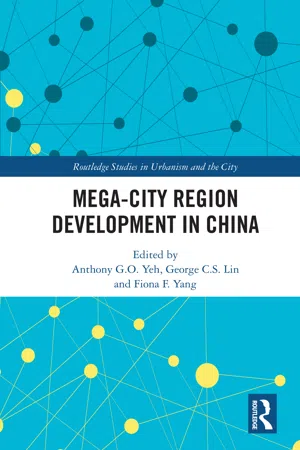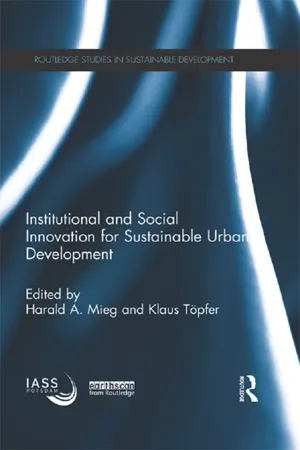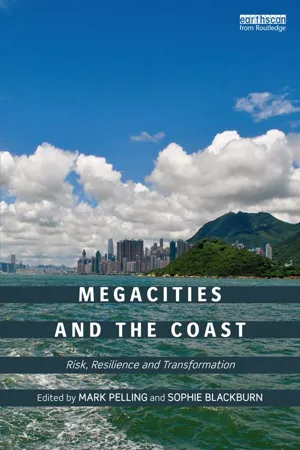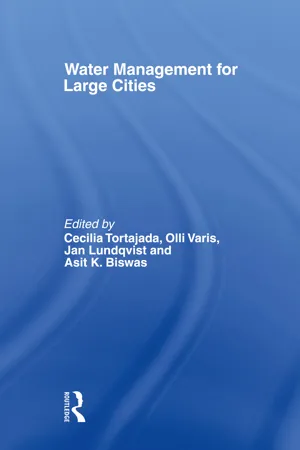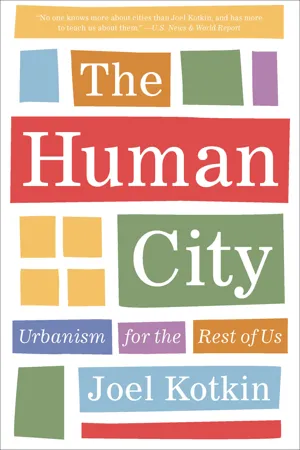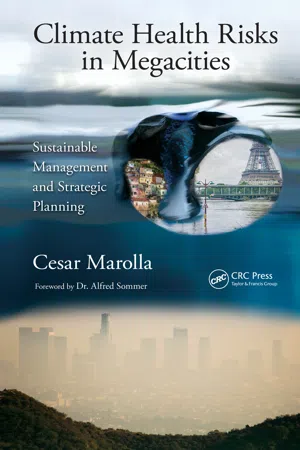Geography
Megacities
Megacities are urban areas with populations exceeding 10 million people. These densely populated cities often face challenges related to infrastructure, housing, transportation, and environmental sustainability. Megacities are significant in shaping global economic, social, and cultural dynamics, and they play a crucial role in understanding urbanization and its impacts on the environment and society.
Written by Perlego with AI-assistance
Related key terms
Related key terms
1 of 4
Related key terms
1 of 3
10 Key excerpts on "Megacities"
- eBook - ePub
- Anthony G.O. Yeh, George C. S. Lin, Fiona F. Yang(Authors)
- 2020(Publication Date)
- Routledge(Publisher)
et al. 2003). Similar or related concepts have been put forward in academic literature or policy documents. For instance, Scott (2001) applied the term “global city-regions” to designate any contiguous set of cities or metropolitan areas whose internal economic and political affairs are bound up in extra-national relationships. In the America 2050 Plan proposed by the Regional Plan Association (2006), they identified 11 “megaregions” where most of the population growth of the country by mid-century will take place. While the aforementioned concepts are all formulated in the Western context, some researchers have also examined the emerging city clusters in developing countries. For instance, McGee (1991) proposed the term “mega-urban region” to describe the economically integrated regions in Southeast Asian countries, which comprise of a central city, developed areas within the transportation corridors, satellite towns and so-called “Desakota” areas in the peri-urban fringe.To avoid ambiguity, we use the term “mega-city region” to describe the territory that comprises a major metropolitan area and the surrounding peri-urban areas or satellite towns, all of which are intensively connected. As defined by Hall and Pain (2006), a mega-city region (e.g., Randstad, the Netherlands) is a cluster of cities or city regions, which are administratively separate but intensively networked, and clustered around one or more larger central cities. These places exist both as separate jurisdictional entities, in which most residents work locally and as parts of a wider functional urban region connected by dense flows of people and information (Hall and Pain 2006). Mega-city regions constitute distinctive regional spatial formations which are undergoing major transformation due to the impacts of globalization and post-Fordist economic governance (Xu and Yeh 2010). They are at the forefront of this transition, and many have become national engines of economic growth. These regions house a rapidly growing population in a relatively small land area. Some expand even faster into urbanized locations of over 50 million inhabitants, as evidenced in developing countries such as China. Their footprint will leave a direct impact on environmental change, land-use pattern, and spatial transformation, as well as on the lives of existing and new city dwellers alike. - Harald Mieg, Klaus Töpfer(Authors)
- 2013(Publication Date)
- Routledge(Publisher)
what the contradictions are that arise out of such a process of producing space’.In the remainder of this chapter, I will present some general arguments to counter typical notions of the megacity-discourse. Additionally, I will assess the making of one of the world’s most prominent Megacities, Mexico City, to back my claim that rapid city growth and high primacy are not necessarily linked to poverty and economic stagnation. From that, I will conclude that whether size matters, and, more importantly, how it matters, depends not on a city’s size, but on the concrete economic, social and political settings in which Megacities are being produced and lived.Megacities—an obstacle to development?According to the United Nations (2010), 21 cities had a population of more than 10 million people in 2010 and were hence classified as Megacities. Of these, five are located in high-income economies, fifteen in middle-income economies, and one in a low-income economy (for the classification, see World Bank, 2012b). The commonsensical conclusion is, thus, that Megacities are a phenomenon of the Third World; but are they really? According to the country classification of the United Nations Development Programme (UNDP), 11 of the 21 Megacities are located in countries with high or very high-human-development standards, while seven are in middle- and three are in low-human-development countries (see Table 10.1 ). Moreover, all except one of the Third World Megacities (ironically Mexico City, which has grown slowly in recent years) are located in countries whose real GDP growth per capita exceeds the world average (2000–2010: 1.3 percent), with nine of these fifteen megacity countries having had average annual growth rates of more than 3 percent, despite the crisis at the end of the decade. Similarly, of the ten Megacities in medium- or low-human-development countries, nine are located in countries that achieved substantial gains in human development in the last decade (annual increase on the UNDP’s Human Development Index (HDI)2- eBook - ePub
The Rise of Megacities
Challenges, Opportunities and Unique Characteristics
- Jerzy Kleer, Katarzyna Anna Nawrot(Authors)
- 2018(Publication Date)
- WSPC (EUROPE)(Publisher)
et al., 2008), ones that are difficult to control, yet characterized by high, and specific at various spatial scale level of selforganization. According to this approach, a large city (urban agglomeration) ceases to expand once it crosses a size threshold, one that is defined by its internal functional effectiveness, as well as its ability to compete in the domain of less than highly specialized functions (such as less technologically advanced manufacturing activities) with smaller urban centres. Before reaching the target size, the city’s spatial structure tends to evolve by assuming a more decentralized, polycentric pattern. Such development sequence is well illustrated by the case of Mexico City mentioned earlier. Following these considerations, the growth limits of today’s Megacities can be estimated to correspond with the population of 15–20 million inhabitants.When interpreted in these categories, the future of Megacities may be seen through lenses of a positive development scenario, the main driving force of which, however, would have to be long-term economic and social development, a progress taking place at the level of individual countries and world regions. This, in turn, would depend upon a host of external political, environmental, as well as other preconditions. An alternative scenario is one of their continuing rapid, chaotic expansion, to be accompanied by growing internal tensions, and leading towards breakages of basic infrastructure and a decline of functions performed, a consequence of which would be a dwindling number of workplaces, and an initially selective, but in a longer perspective large-scale population outflow. Such a course of events could be initiated at a local or regional level by a massive, city-bound population exodus from rural areas, an effect of natural disasters, and a general deterioration of environmental conditions related to climate change. Once their absorption capacity was exceeded, the Megacities could no longer fulfil their complex functions of integrating local economies into global economic circuit. With regard to spatial population flows, their position would change from one of the important destinations to that of mainly origins of migration and refugee movement, on both internal and international scale. - eBook - ePub
Megacities and the Coast
Risk, Resilience and Transformation
- Mark Pelling, Sophie Blackburn(Authors)
- 2014(Publication Date)
- Routledge(Publisher)
The purpose of this section is to highlight some of the most significant trends in coastal megacity development, which have bearing on the nature of risk and opportunity in these areas. Note that due to the large degree of contradiction and debate which surrounds megacity growth statistics, what is presented here is an overview of key narratives. It should also be noted that many of the issues identified are not limited to the spatial fixidity of coastal Megacities – that is, they are more to do with cities than with the coast and also apply in non-coastal contexts – however, they are of particular significance in coastal Megacities due to the concentration of risk, assets and environmental sensitivity in these areas as previously outlined. Given the difficulties outlined above, a broad definition of Megacities and urban regions is adopted.4.1 The ‘new’ Megacities: growth in low-and middle-income countries
Between 1975 and 2000, the number of Megacities in low-and middle-income countries rose from two to 13, with the global megacity population increasing more than seven-fold to 165 million (more if wider agglomeration boundaries are drawn) (Cohen 2006). Looking at Plate 1 , of the seven new Megacities anticipated by UN-HABITAT to emerge by 2025, all are in low-or middle-income countries with only four remaining in developed countries. Even more significantly, by 2011 three of these projections have already become reality, with Lagos, Shenzhen and Guangzhou already having passed ten million in population – and Jakarta is not far behind (UN-DESA 2012b). That two Chinese cities have done this reflects the ‘staggeringly high’ growth rates being experienced in China, which exceeded 10 per cent in 2008 (UN-HABITAT 2008).These data indicate that generally, urban growth rates are higher in Asia, Africa and Latin America compared to the ‘older’ Megacities in Europe, North America and Japan. Nevertheless despite the rapid growth of these ‘new’ Megacities, recent reports are keen to dispel popular visions of a future led by ‘explosive’ urbanisation – a myth largely driven by Megacities’ high visibility and the media (Satterthwaite 2010). Whilst it is true that Megacities have grown in size and number in the last few decades, this growth has been much slower than expected – particularly in high-income nations (Angel et al. - eBook - ePub
- Cecilia Tortajada, Olli Varis, Asit Biswas, Jan Lundqvist(Authors)
- 2013(Publication Date)
- Routledge(Publisher)
This implies that in 2025, at the global level, rural areas will have to supply food, energy and other commodities to towns and cities that will house almost twice as many people as the rural areas do. The global cycles of carbon, nutrients, water and other substances will be notably distorted, while markets perturb age-old social systems.The aim of this paper is to outline the world's urban development, and in particular the growth of the largest agglomerations, known as Megacities. This analysis draws attention to nine that have been selected to provide a comprehensive analysis of water management in Megacities. The cities and the evolution of their populations are presented in Figure 1 .Urbanization, Megacities and Development: A Global Outlook
Let us continue to adopt the perspective of mankind only one generation ahead in time—the shortest possible span for any consideration of sustainable development. Each year, the world population grows by some 70 million. Almost all of this is urban growth in developing countries, although mainly it is due to migration; fertility rates are far lower in urban areas than in rural ones (UN, 2002). Urbanization and rural and urban population by continents is shown in Figure 2 .In Africa and in Asia, the proportion of urban population to rural is around 1:3, while in all the other continents it is more than 2:3. Therefore, urbanization is expected to be most rapid in Asia and in Africa (Figure 1 ). In China, it has been estimated that by 2025 the urban population will have grown by 350 million. China's cities currently house ‘only’Figure 1 World's biggest cities in 2015 with Johannesburg. Population growth between 1985 and 2015 is shown. Names of the study cities are highlighted in bold type. Source : UN (2002).500 million, and they already face severe problems of environmental and resource degradation.Figure 2 Rural and urban population by continent. Note : In the upper graph, the upper columns represent urban population and the lower ones rural population. Source : UN (2002).Megacities
Urbanization is seen most dramatically as the growth of large urban agglomerations. The UN uses the term ‘megacity’ for one that has more than 5 million inhabitants; a ‘big city’ has more than 1 million. These terms are used also in this text. Whereas in 1985, there were 31 Megacities on this planet, the number had grown to 40 by 2000, and is expected to grow to 58 by 2015. - eBook - ePub
- C. Greig Crysler, Stephen Cairns, Hilde Heynen, C. Greig Crysler, Stephen Cairns, Hilde Heynen(Authors)
- 2012(Publication Date)
- SAGE Publications Ltd(Publisher)
The metacity was born in the exhaustion of metropolitan and megalopolitan urban models, the rise of the demands of activism in civil rights and environmentalism and the emergence of new sensing, communication and imaging technologies. The revival of metropolitan architecture appealed to tourist circuits of global elites and for staging spectacular events such as the Beijing Olympics, but the controlled world order and legibility of the metropolis could never be fully resurrected. The megalopolis as well came to a severe crisis with the growing scarcity of oil, and the environmental consequences of burning fossil fuels finally acknowledged at the Kyoto Accords of 1998. The term ‘metacity’ appeared in a millennial anxiety about overpopulation and renewed fears of the limits of growth, and for UN-HABITAT it refers to cities with a population over twenty million (2006). But the size of a few extra large cities is not the important question of the metacity, and population predictions have been consistently overestimated. For us the metacity does not refer to an extra-large conurbation, but an urbanization of the entire planet – including what was thought of as ‘village’, ‘rural’ or ‘remote’ – through new models of mobility and communication. The metacity implies that which exists above and beyond the traditionally defined city, metropolis and territory, when urban form becomes unbounded, uncontrolled and at once urban and rural, and everywhere is both centre and periphery.If the megalopolis and megacity were created by the political unbounding of the colonial world system, the metacity emerged according to the logic of late global capital and the new information and communication technology tools which allowed for new forms of both concentration and dispersal. Recent development has been led by aggressive speculation and profit-seeking during a time of deregulation of global financial systems. This new global city based on the dynamic generation of urban form through credit, risk and capital speculation has occurred at a moment where nature itself has been reconceived in a more dynamic way. Contemporary theories of disturbance ecology give us an understanding of nature neither in balance nor equilibrium, but in a constant state of flux. The ecology of the metacity should be understood as a complex adaptive system in disequilibrium, and the social actors of the city are seen as an integral part rather than separated from nature. - eBook - ePub
The Human City
Urbanism for the Rest of Us
- Joel Kotkin(Author)
- 2016(Publication Date)
- Agate B2(Publisher)
5 —poses new and often enormous challenges for the urban future. Even as they demonstrate the enormous appeal of city life, these new Megacities also represent an enormous break in urban history in two critical ways: their unprecedented size and their relative lack of the kind of economic base that drove urban development in Europe, America, and more recently, eastern Asia. No city in the 19th or 20th century was nearly as large, or grew in countries as poor, as those we see today.Today’s Megacities, first of all, reflect a profound shift in urban scale. In 1800, only Beijing had a population exceeding 1 million. In 1900, greater London was the world’s largest urban center with 6.5 million people.6 Today, there are more than 50 cities with larger populations, including the largest, Tokyo, whose population exceeds 35 million.7Until 1975, Tokyo was one of only three Megacities—New York and Mexico City being the others. Over the next 40 years, Megacities cropped up around the planet. There were 34 such cities in 2014, which now account for roughly 13 percent of the world’s urban population and 7 percent of the world’s total population. Overall, the population of the world’s 100 largest cities has grown to 10 times what their combined size was in 1900.8 As in Mumbai, most of this growth has been driven by the migration of rural people to the city. This reflects Marx’s notion that modernity is essentially “the urbanization of the countryside.” What differs today is the unprecedented scale of this migration.9The other big divergence lies in the economic underpinnings of urban growth. In the past, urban growth generally occurred most rapidly in the most prosperous and fastest-growing regions. Cities like Tokyo and Osaka, originally castle towns, expanded rapidly by developing their industrial and trading economies. This closely followed what had already occurred throughout the West in places like New York and London, which became large due to their varied and expanding economies.10 - eBook - ePub
Climate Health Risks in Megacities
Sustainable Management and Strategic Planning
- Cesar Marolla(Author)
- 2016(Publication Date)
- CRC Press(Publisher)
Section IVCase Study: Researched Megacities
Passage contains an image
14
Overview of Megacities Used in Case Study
Megacities are important centers of population concentration and growth, and derive their prosperity and importance through their long-standing commercial connections with the rest of the world. Most of these cities are located on or near a coast, which facilitates the flow of trade and contributes to their prosperity. Others are located near major rivers that serve as a channel for commerce (De Sherbinin et al., 2007).Megacities are confronting many issues related to a changing climate and, as highlighted in earlier chapters, the vulnerabilities are much greater among coastal cities. Sao Paulo and Rio de Janeiro are good examples. The two are located on Brazil’s long coastline (8,000 km or 4,900 miles). Climate change exposes these cities to environmental risks, such as sea-level rise, severe storms, floods, landslides, vector-borne diseases that are a consequence of rising temperatures, variability in rainfall patterns, and severe weather events (Costa Ferreira et al., 2011).This research focused on the cities of New York City, Rio de Janeiro, Beijing, Los Angeles, London, Mumbai, and Lagos to strategize adaptation and mitigation plans. These seven Megacities are considered highly vulnerable to the impacts of climate change in ways that will affect the urban population’s health. New York and Rio de Janeiro have similarities because they are located in coastal zones, have dense urban populations, dynamic economies, and global trade resources. Therefore, these cities, and others located in coastal regions, should be a priority for social and environmental policies that seek forms of mitigation and adaptation (Costa Ferreira et al., 2011).Los Angeles has a vast territory with a dense population that is highly vulnerable to heat waves, windstorms, and flooding. The county of Los Angeles encompasses a diverse ecosystem that makes adaptation and mitigation to climate change a priority to minimize threats to such a large and diverse population (Kersten et al., 2012). - eBook - ePub
- Rajiv Biswas(Author)
- 2018(Publication Date)
- Palgrave Macmillan(Publisher)
These infrastructure needs will be wide-ranging, including power, sanitation, public transport and urban housing. As urban populations grow, governments will also face rising demand for educational infrastructure as well as healthcare. As many governments of developing countries lack the fiscal resources to finance the necessary infrastructure financing entirely from budget revenues, a key challenge is mobilizing other financial resources for infrastructure development. Governments of developing countries face many other challenges as cities continue to grow, including tackling urban crime, environmental pollution and generating sufficient employment growth. Megacities in Developing Countries The fast growth of urban populations in developing countries has driven the rapid expansion of major cities. This has resulted in a significant increase in the number of Megacities, defined as urban agglomerations with a total population of 10 million persons or more. In 1990, United Nations urbanization statistics show that there were 10 cities worldwide, including in developed countries, which were classified as Megacities. By 2014, the number of Megacities had almost tripled, to 28 Megacities. By 2030, the UN urbanization projections indicate that there will be 41 Megacities globally. The number of Megacities in developing countries has risen very rapidly, from just 6 Megacities in 1990 to 21 Megacities by 2014. By 2030, the number of Megacities in developing countries is projected to rise to 34. Furthermore, the number of cities in developing countries with a population between 5 million and 10 million persons is projected to rise from 32 in 2014 to 49 by 2030 - eBook - ePub
The Towers of New Capital
Mega Townships in India
- P. Tiwari(Author)
- 2016(Publication Date)
- Palgrave Macmillan(Publisher)
1 The Challenge of Megacities in India Piyush TiwariAbstract:This chapter sets the stage for discussion in the book by briefly presenting the political, economic and urban context within which mega townships’ development has been envisaged to be at the forefront of India’s aspiration to become a global economy. The chapter also outlines the key literature on the topic. With mega townships as the tool, this book analyses complexity, scale and challenges associated with the development paradigm in India. The chapter also introduces to the readers the interdisciplinary lenses through which mega townships have been analysed in the book.Tiwari, Piyush, ed. The Towers of New Capital: Mega Townships in India . Basingstoke: Palgrave Macmillan, 2016. DOI : 10.1057/9781137586261.0005.IntroductionGlobalization has manifested itself in numerous ways – economic, political and social – bestowing its benefits through economic growth and rise in income across nations in global north and south. The past two decades have witnessed phenomenal economic growth in emerging economies like India, China, Brazil, Russia, South Africa and emergence of cities in these economies as crucible of energy and abundant human activity. Now cities in the developing world aspire to become a ‘world city’ or a ‘global city’ as their economies link up with the international markets. In order to attract capital, nations’ governments have started to intervene through space-based interventions in urban regions (Brenner, 1998). Some examples of such interventions (termed ‘global fixes’ by Brenner, 1998) in India are Special Economic Zones or mega townships on the fringes of the existing Megacities. As strategies of territorial restructuring, these projects are socially produced and intended to facilitate capital investment and accumulation (Kennedy et al., 2011, quoting Brenner, 1998). There is increasing evidence that policymakers in emerging countries are adopting city-centric strategies, but there is significant variation in the specific model used which depends on each country’s economy; its engagement with global capitalism; and local, social and political institutions (Kennedy et al., 2011); India is no exception and the model, albeit with its many variants, has largely been space-based, infrastructure-led intervention.
Index pages curate the most relevant extracts from our library of academic textbooks. They’ve been created using an in-house natural language model (NLM), each adding context and meaning to key research topics.
Explore more topic indexes
Explore more topic indexes
1 of 6
Explore more topic indexes
1 of 4
